Winter Trifecta |
|||||||||||||
 |
 |
||||||||||||
Knitted hat, neck-warmer and wrist warmers in DROPS Snow or DROPS Wish. The piece is worked with rib.
DROPS 225-17 |
|||||||||||||
|
------------------------------------------------------- EXPLANATIONS FOR THE PATTERN: ------------------------------------------------------- RIDGE/GARTER STITCH (worked back and forth): Knit all rows. 1 ridge = knit 2 rows. PATTERN: Hat: See diagrams A.1 and A.2. Neck-warmer: See diagrams A.1, A.3 and A.4. Wrist-warmers: See diagram A.1. The diagrams show all rows in the pattern from the right side. DECREASE TIP (evenly spaced – for neck-warmer): To work out how to decrease evenly, count the total number of stitches on the needle (e.g. 29 stitches) and divide by the number of decreases to be made (e.g. 7) = 4.1. In this example, decrease by knitting together approx. each 3rd and 4th stitch. INCREASE TIP (for neck-warmer): All increases are worked from the right side: Increase 1 stitch by making 1 yarn over On the next row purl the yarn over twisted to avoid a hole. Then work the new stitch in stocking stitch. CASTING-OFF TIP: To avoid the cast-off edge being tight you can cast off with a larger size needle. If the edge is still tight, make 1 yarn over after approx. each 6th stitch at the same time as casting off; the yarn overs are cast off as normal stitches. ------------------------------------------------------- START THE PIECE HERE: ------------------------------------------------------- HAT – SHORT OVERVIEW OF THE PIECE: The piece is worked in the round with circular needle, bottom up. The turn-up is worked from the wrong side, the piece is then turned and the rest of the hat is worked in the opposite direction and from the right side. Change to double pointed needles when necessary. HAT: Cast on 64 stitches with short circular needle size 8 mm and DROPS Snow or DROPS Wish. Work pattern in the round according to diagram A.1 for 12 cm. Now turn the piece, so the rest of the hat is continued in the round but in the opposite direction. When the hat is finished the turn-up will have the same textured pattern as the rest of the hat. Continue A.1in the round. REMEMBER THE KNITTING TENSION! Work until the piece measures 24 cm (including the 10 cm turn-up; there is approx. 8 cm left to finished length – work to desired length). Continue with A.2 (= 4 repeats of 16 stitches). When the diagram is finished in height, there are 32 stitches. Work 2 rounds with knit 1 / purl 1. Then knit all stitches together 2 and 2 = 16 stitches. Knit 1 round. Knit all stitches together 2 and 2 = 8 stitches. Cut the strand, pull it through the remaining stitches, tighten and fasten well. The hat measures approx. 35 cm (= 25 cm with 10 cm turn-up). ------------------------------------------------------- NECK-WARMER – SHORT OVERVIEW OF THE PIECE: The piece is worked back and forth in 2 sections, with circular needle and is sewn together at the shoulders. A double neck is worked to finish. FRONT PIECE: Cast on 43-45 stitches with circular needle size 8 mm and DROPS Snow or DROPS Wish. Work rib as follows: 1 edge stitch in GARTER STITCH – read description above, A.1 until there are 2 stitches left, work the first stitch in A.1, 1 edge stitch in garter stitch. Continue this pattern back and forth. When the rib measures 4 cm, work the next row from the right side as follows: Work A.3 over the first 7 stitches, knit 29-31 and decrease 7 stitches evenly over these stitches – read DECREASE TIP, work A.4 over the last 7 stitches = 36-38 stitches. Change to circular needle size 9 mm. Continue with stocking stitch and pattern over the 7 stitches on each side. REMEMBER THE KNITTING TENSION! When the piece measures 5 cm, increase 1 stitch on the inside of the 8 stitches on each side – read INCREASE TIP (= 2 stitches increased). Increase like this every 5 cm a total of 3 times on each side = 42-44 stitches. Continue working until the piece measures 20-22 cm. Now place the middle 8 stitches on a thread for the neck and each shoulder is finished separately. Left shoulder: Work the next row from the right side as follows: Work pattern as before until there are 5 stitches left before the neck, knit 2 together, knit 2 and 1 edge stitch in garter stitch. Work 1 row back from the wrong side as before. Continue back and forth like this, decreasing for the neck on each row from the right side a total of 4 times = 13-14 stitches. Continue working until the piece measures 28-30 cm. Cast off with knit from the right side. Right shoulder: Work the next row from the right side as follows: 1 edge stitch in garter stitch, knit 2, slip 1 stitch as if to knit, knit 1 and pass the slipped stitch over (= 1 stitch decreased), work the rest of the row as before. Work 1 row back from the wrong side. Continue back and forth like this, decreasing for the neck on each row from the right side a total of 4 times = 13-14 stitches. Continue working until the piece measures 28-30 cm. Cast off with knit from the right side BACK PIECE: Cast on 43-45 stitches with circular needle size 8 mm and DROPS Snow or DROPS Wish. Work rib as follows: 1 edge stitch in garter stitch, A.1 until there are 2 stitches left, work the first stitch in A.1, 1 edge stitch in garter stitch. Continue this pattern back and forth. When the rib measures 4 cm, work the next row from the right side as follows: Work A.3 over the first 7 stitches, knit 29-31 and decrease 7 stitches evenly over these stitches, work A.4 over the last 7 stitches = 36-38 stitches. Change to circular needle size 9 mm. Continue with stocking stitch and pattern over the 7 stitches on each side. When the piece measures 5 cm, increase 1 stitch inside 8 stitches on each side – remember INCREASE TIP (= 2 stitches increased). Increase like this every 5 cm a total of 3 times on each side = 42-44 stitches. Continue working until the piece measures 26-28 cm. Now place the middle 14 stitches on a thread for the neck and each shoulder is finished separately. Continue by casting off 1 stitch for the neck = 13-14 stitches on the shoulder. Continue working until the piece measures 28-30 cm. Cast off with knit from the right side. Work the other shoulder in the same way. ASSEMBLY: Sew the shoulder seams together with grafting stitches, inside the cast-off edge. DOUBLE NECK: Knit up approx. 64 stitches around the neck, from the right side and inside the 1 edge stitch, with circular needle size 8 mm and DROPS Snow or DROPS Wish. The number of stitches should be divisible by 2. Work A.1 in the round. When the neck measures 20 cm, cast off with knit over knit and purl over purl. It is important the edge is not tight – read CASTING-OFF TIP. Fold the neck double to the inside and sew down. To avoid the neck being tight and the neck rolling outwards, it is important the seam is elastic. ------------------------------------------------------- WRIST-WARMERS – SHORT OVERVIEW OF THE PIECE: The piece is worked in the round with double pointed needles. WRIST-WARMER: Cast on 24 stitches with double pointed needles size 8 mm and DROPS Snow or DROPS Wish. Knit 1 round. Then work A.1 in the round. REMEMBER THE KNITTING TENSION. When the piece measures 10 cm, increase 2 stitches as follows: Knit 1 twisted, purl 1, 1 yarn over (= 1 stitch increased), work the next 11 stitches as before, purl 1, 1 yarn over (= 1 stitch increased), work the last 11 stitches as before. You have increased 1 stitch on each side of the piece = 26 stitches (work the yarn overs twisted on the next round and then purl the new stitches). Continue with knit-twisted over knit-twisted and purl over purl. When the piece measures 16 cm, cast off with knit over knit and purl over purl – read CASTING-OFF TIP. Work 1 more wrist-warmer in the same way. |
|||||||||||||
Diagram explanations |
|||||||||||||
|
|||||||||||||
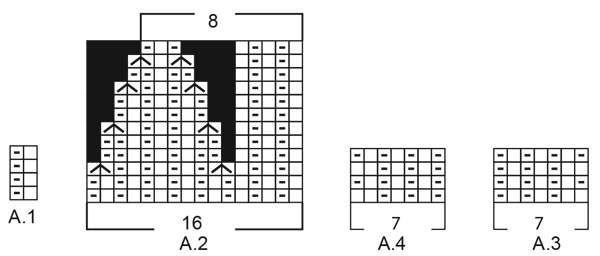
|
|||||||||||||
|
Have you made this or any other of our designs? Tag your pictures in social media with #dropsdesign so we can see them! Do you need help with this pattern?You'll find tutorial videos, a Comments/Questions area and more by visiting the pattern on garnstudio.com. © 1982-2024 DROPS Design A/S. We reserve all rights. This document, including all its sub-sections, has copyrights. Read more about what you can do with our patterns at the bottom of each pattern on our site. |
|||||||||||||








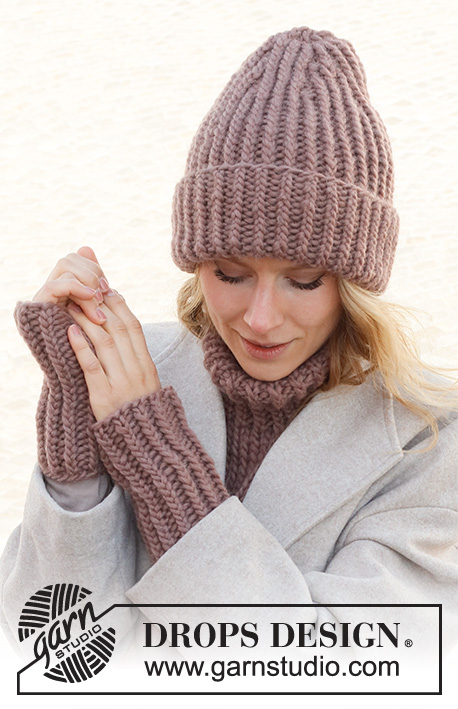

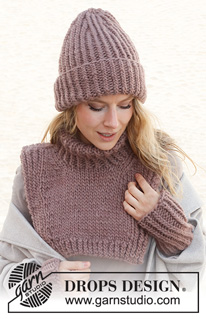
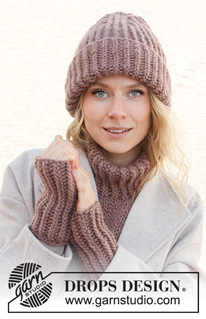
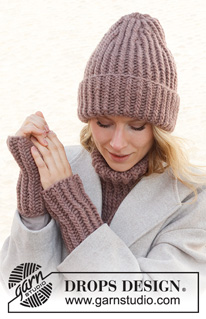











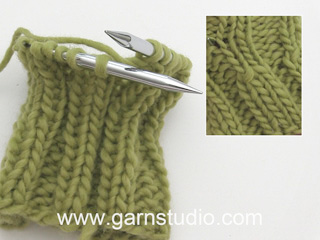





















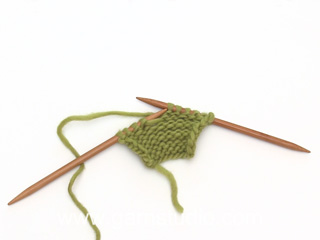





























Comments / Questions (19)
Hejsa. Jeg har lige færdiggjort huen, men har undret mig over opskriften. Til slut når man strikker 2 masker ret sammen, skulle det ikke have været 2 drejet ret sammen? Mvh.
14.01.2024 - 21:59DROPS Design answered:
Hej Shirly, det må du gerne gøre, men du kommer ikke til at se det når alle masker er trukket sammen og hæftet :)
16.01.2024 - 14:21Hallo liebes Team, bei der Zunahme bei den Armstulpen bleiben 10 Maschen nach der 2.Abhahme übrig . ( nicht 11 wie im Text steht)
19.12.2023 - 14:01Hej! Har börjat sticka halsvärmare Winter Trifecta. Saknar stickor nr 9. Hur kan jag ändra mönstret så att det blir bra med nr8? Öka några maskor och varv tänker jag...\r\nMvh Åsa
26.11.2023 - 01:31DROPS Design answered:
Hei Åsa. Design avd. har dessverre ikke mulighet til å regne om oppskriften ved å bytte pinne nr. og evnt hva garnmengden vil bli. Men du kan ut fra den oppgitte strikkefastheten og den strikkefastheten du får ved å bruke en mindre pinne str. regne ut hvor mange masker du trenger. Og så følger du bare de cm målene som er oppgitt i oppskriften på høyden. mvh DROPS Design
27.11.2023 - 09:37Hallo liebes Drops-Team, ich stehe etwas auf dem Schlauch bzgl. des Kragenschals. Ich verstehe das mit den 64 Maschen nicht, wenn ich den Kragen stricken, nehme ich die stillgelegten Maschen des Vorderteils und Rückenteils wieder auf und dazwischen nehme ich neu Maschen auf, sodass es insgesamt 64 Maschen ergibt oder was passiert mit den stillgelegten Maschen? Danke für die Hilfe, liebe Grüße, Maren!
16.05.2023 - 11:48DROPS Design answered:
Liebe Maren, es sind 8 stillgelegten Maschen am Vorderteil + 4 Maschen beidseitig abgekettet + 16 M am Rückenteil + 1 Masche beidseitig + fassen Sie 16 Maschen beidseitig zwichen den Abkettenreihen für Halsausschnitt so haben Sie: 8 + 4 + 4 + 14 + 1 + 1 + 16 + 16 = 64 Maschen. Viel Spaß beim stricken!
16.05.2023 - 14:25Når jeg har vendt arbeidet etter vrangbord begynner jeg da med en rett maske?
31.01.2023 - 15:02DROPS Design answered:
Hei Jeanette, Hvis du avsluttet vrangborden med 1 rett maske, blir denne vrang når du snur arbeidet. Hvis du avsluttet med vrang blir den første masken rett. God fornøyelse!
01.02.2023 - 07:17Er det mulig å følge denne oppskriften men strikke "vanlige" istedenfor vridde masker? Vil strikkefastheten da være den samme?
24.11.2022 - 19:39DROPS Design answered:
Hej Tina, ja bare du holder den strikkefasthed som står i opskriften :)
30.11.2022 - 13:52Tuo "taitereuna" hämmentää. Työn kääntäminen ei vaikuta lopputulokseen mitenkään muuten, kuin että käännöskohtaan jaa reikä. Mikä pn tarkoitus tuolla kääntämisellä? Sama lopputulos, mutta siistimpi, olisi jos työtä vain jatkaisi normaalisti ja kääntäsi sen 10- 12 cm viimeistelyvaiheessa työn päälle. Mikä siis on se 'juju' tässä olevinaan?
22.10.2022 - 16:55Hallo,\r\nWenn ich bei der Mütze dann innen weiter stricke, dann sehe ich keinen Unterschied, oder muss ich die linken Maschen dann rechts stricken und rechte Maschen links?\r\n\r\nVielen Dank\r\nManuela
06.01.2022 - 15:28DROPS Design answered:
Liebe Manuela, stricken Sie wie zuvor (= A.1) (die letzte Maschen der Runde war die 1. Masche in A.1, und ist jetzt die 1. Masche der Runde = 1. Masche A.1 = rechts verschränkte Masche). Viel Spaß beim stricken!
06.01.2022 - 16:35Jag ska sticka mössan. Förstår dock inte vad det betyder att ”vända arbetet”. Ska jag ta stickorna och vända dem så den som är den med garnet på blir den som matar? Alltså spegelvända det? Eller ska jag göra något annat med stickorna ? Ska sidan där tråden är bli på andra sidan alltså , genom att vända det?
01.12.2021 - 21:49DROPS Design answered:
Hej Louise. Du vänder hela arbetet (du viker alltså ner arbetet under stickorna när du vänt det) och börjar sticka tillbaka där du precis har stickat. Mvh DROPS Design
03.12.2021 - 11:26Hi, how do I avoid a hole when working from the wrong side? Thanks for your response. S
28.11.2021 - 22:50DROPS Design answered:
Dear Sharon, you can avoid having a hole when turning the piece, if you pull the yarn really thight at the next stitch. If the hole is still there, you can try to a stitch by raising the ladder between two stitches, putting it on the needle twisted and knit together with the first stitch. Happy
28.11.2021 - 23:18